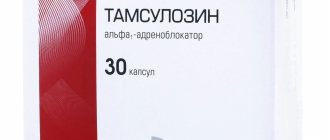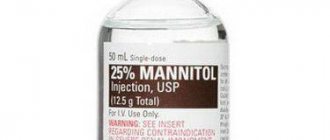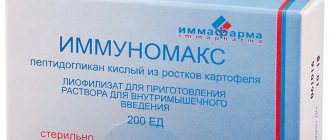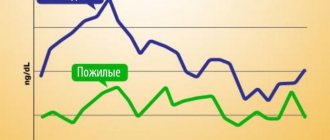Composition and release form
The description of the drug Setegis reports that the main active ingredient in its structure is terazosin in the form of hydrochloride dihydrate.
This component can be presented in different volumes, on which the effectiveness of the medicine directly depends. The manufacturer produces the drug with 1, 2, 5 or 10 mg of terazosin. The drug Setegis additionally includes stabilizing and auxiliary ingredients - lactose, corn starch in gelatinized form, talc, magnesium stearate and povidone.
Patients should note additional differences between tablets with different terazosin concentrations:
- 1 mg – white, round, flat, with a bevel on one and engraved “E” and the number 451 on the other, odorless;
- 2 mg – yellow (dyed with quinoline yellow ariavit), round, flat, beveled on one and engraved with “E” and the number 452 on the other, odorless;
- 5 mg – pale orange in color (Ariavit Sunset Yellow), round, flat, with a bevel on one and engraved “E” and the number 453 on the other, odorless;
- 10 mg – orange (Ariavit Sunset Yellow), round, flat, with a bevel on one and engraved “E” and number 454 on the other, odorless;
A standard PVC blister contains 10 Setegis tablets, placed in a cardboard box with a capacity of three blisters (30 tablets). Setegis is produced in Hungary.
General information and cost
Belongs to the pharmacological group of alpha-adrenaline blockers. It is a symptomatic remedy.
Active ingredient: chemical compound terazosin hydrochloride dihydrate - terazosin.
Produced in Hungary, in tablet form containing the active ingredient in the dosage:
- 1 mg;
- 2 mg;
- 5 mg;
- 10 mg.
Packaged in 10 pieces per contour plate, one package contains 30 tablets. The tablets have different colors, depending on the dosage.
Domestic production of the presented medicine has not been established in Russia. The original medicine, as well as analogues of Setegis - only foreign release:
| Drug name | Active ingredient | Manufacturer |
| Terazosin | terazosin | Macedonia, Canada |
| Terazosin-Teva | Israel | |
| Cornam | Switzerland, Slovenia |
You can buy it in a pharmacy, strictly according to a doctor’s prescription, the price of the medicine is quite affordable, in Russia you can find the dosage of the drug 2 mg and 5 mg:
| Setegis 2 mg | Setegis 5 mg | ||||
| Minimum price | average price | Maximum price | Minimum price | average price | Maximum price |
| 635 rubles | 770 rubles | 890 rubles | 820 rubles | 1220 rubles | 1450 rubles |
Setegis
Active substance:
Terazosin*
Pharmgroup:
Alpha blockers
Average price in pharmacies
| Name | Manufacturer | average price |
| Setegis 0.002 n30 tab | Egis Pharmaceutical Plant CJSC | 852.00 |
| Setegis 0.005 n30 tab | Egis Pharmaceutical Plant CJSC | 1335.00 |
Analogs for the active substance:Cornam Terazosin Terazosin-Teva Haytrin | Application area:Prostate adenoma BPH Vasorenal hypertension Sudden increase in blood pressure Sudden increase in blood pressure Hypertensive circulatory disorder Hypertensive circulatory disorder Hypertensive state Hypertensive state Hypertensive crises Hypertensive crises Hypertension Hypertension Arterial hypertension Arterial hypertension Hypertension is malignant Hypertension is malignant Hypertension, symptomatic Essential hypertension Hypertonic disease Hypertensive crises Hypertensive crises Hypertensive crisis Hypertensive crisis Hypertension Prostatic hypertrophy Prostate hypertrophy BPH Dysuric disorders caused by benign prostatic hyperplasia Dysuric disorder in benign prostatic hyperplasia Dysuria with prostate adenoma Benign prostatic hyperpalasia Benign prostatic hyperplasia Benign prostatic hyperplasia stages 1 and 2 Benign prostatic hyperplasia stages 1 and 2 in combination with prostatitis Benign prostatic hyperplasia grade I Benign prostatic hyperplasia grade II Benign prostatic hypertrophy Prostate disease Malignant hypertension Malignant hypertension Malignant hypertension Malignant hypertension Isolated systolic hypertension Hypertensive crisis Hypertensive crisis Exacerbation of hypertension Exacerbation of hypertension Acute urinary retention associated with benign prostatic hyperplasia Paradoxical ischuria Primary arterial hypertension Renal hypertension Renovascular arterial hypertension Renovascular hypertension Symptomatic arterial hypertension Transient arterial hypertension Transient arterial hypertension Essential arterial hypertension Essential arterial hypertension Essential hypertension Essential hypertension |
Method of administration and adaptation
In the first days of taking the medicine, there is a risk of the body reacting to terazosin, which is expressed in a sharp drop in blood pressure. This is accompanied by dizziness, nausea and often short-term loss of consciousness. The body must get used to and adapt to the active ingredient.
Even after a break of several days, the situation may repeat itself again. Not all patients react to this substance in this way, only about 1 percent of the total.
How to properly adapt to the drug Setegis:
- it is necessary to remember that orthostatic manifestations most often occur an hour and a half after taking the pill;
- exclude a sudden change in body position from a lying or sitting position when rising to a vertical position (this lifting must be done smoothly and slowly);
- exclude the intake of alcoholic beverages for the entire duration of treatment, and also avoid staying in rooms with high air temperatures;
- physical and emotional stress should be moderate;
- Regularly monitor your blood pressure levels.
When additional diuretics are added to complex therapy, the dosage of the drug is reviewed with the possibility of being reduced.
Parallel intake of any adsorbents and agents that reduce the acidic environment of the stomach - the absorption of the active substance is reduced, and the result of the action is reduced.
Operating principle
Like other alpha1-adrenergic receptor antagonists, terazosin in Setegis selectively and competitively blocks them in the tissues of the bladder, prostate and vessels passing through the pelvic organs.
At the same time, the drug has the following effects on the body:
- relaxes the muscles of the bladder neck and prostate gland;
- reduces symptoms of dysuric abnormalities in BPH;
- normalizes the balance of lipids and triglycerides in the blood plasma;
- reverses the process of hypertrophy of the left ventricle of the heart.
The consequence of the effects produced by terazosin is a decrease in the tone of the smooth muscles of the genitourinary system and pelvic floor. This naturally improves urodynamics, eliminates residual urine syndrome and eliminates the symptoms of urinary tract obstruction (causing corresponding discomfort).
As for the prostate gland itself, selective blocking of alpha1-adrenergic receptors in it leads to a natural decrease in the volume of the prostate after swelling caused by benign hyperplasia of its tissues.
The instructions for use describe the pharmacokinetics of Setegis as follows:
- Terazosin is quickly absorbed into the blood after oral administration of the drug;
- metabolized in the liver and after 12-24 hours is excreted by the kidneys and intestines.
A stable peak of improvement in the patient's condition with BPH is achieved 10-14 days after the start of therapy, and lasts after the end of treatment for at least another month.
Reviews about Setegis
Most often, reviews of Setegis are left by patients taking the drug due to benign prostatic hyperplasia. Their opinions were divided. Some describe the high effectiveness of Setegis and its rapid action, others write about the insufficiency or lack of effect.
According to doctors, a significant improvement in the condition is observed within 4 months of treatment: the volume of urination and the speed of urine flow increase, the time of urination and the volume of residual urine decrease. Setegis is well tolerated. Side effects occur in no more than 9% of patients, while discontinuation of therapy due to adverse reactions is required only in approximately 3% of cases.
Pharmacological properties of the drug Setegis
Terazosin (2-6,7-dimethoxy-4-quinazolinamine monohydrochloride dihydrate). Terazosin is a selective α1-adrenergic receptor blocker. Its antihypertensive effect is due to the blockade of postsynaptic α1-adrenergic receptors, which leads to vasodilation, a decrease in peripheral vascular resistance and a decrease in venous return. Terazosin is a long-acting drug, which allows it to be prescribed for hypertension (arterial hypertension) once a day. Long-term treatment is not accompanied by the development of reflex tachycardia; it has little effect on cardiac output, renal perfusion, and glomerular filtration rate. The drug also increases the rate of urine outflow and reduces obstructions to its outflow. This leads to improved urodynamics in patients with benign prostatic hyperplasia (BPH). The drug does not affect the size of the prostate gland. Terazosin is quickly and almost completely absorbed from the digestive tract after oral administration. Its bioavailability is 90%, the action begins 15 minutes after application. The maximum concentration of the drug in the blood plasma is achieved 1 hour after administration. The therapeutic effect develops within 2–3 hours. The antihypertensive effect persists for 24 hours after taking the drug. Terazosin is 90–94% bound to plasma proteins. Extensively metabolized in the liver by hydrolysis, demethylation and dealkylation to form 5 different metabolites. The half-life is 12 hours and practically does not change with impaired renal function. Approximately 10 and 20% of the dose taken are excreted unchanged in urine and feces, respectively.
Overdose
Symptoms: loss of coordination of movements, arterial hypotension, fainting.
The patient should be placed in a horizontal position with legs slightly elevated. There is no specific antidote for terazosin. Hemodialysis is ineffective due to the high degree of binding of the drug to plasma proteins. Treatment is symptomatic. If shock develops, plasma replacement agents are prescribed to increase the volume of circulating blood, then vasopressor drugs are administered. It is necessary to maintain water and electrolyte balance.
Analogues and prices
Generics of terazosin can be considered direct structural analogues of Setegis, which can easily replace this drug:
- Terazosin-Teva;
- Cornam;
- Haytrin.
As for other representatives of the group of alpha1-blockers (and their synonyms), the following medications can be distinguished on the Russian market:
- Alfuzosin, Alfuprost, Dalfaz;
- Doxazosin, Artezin, Kamiren, Cardura, Urocard;
- Prazosin, Polpressin;
- Silodosin, Urorek;
- Tamsulosin, Hyperprost, Omnic, Sonizin, Fokusin;
- Prostamol Uno, Permixon, Prostagut, Tykveol, Trianol.
You can buy medications at a pharmacy, and the approximate cost of the listed medications is as follows:
| Name | Price, rub.) |
| Setegis | 900 |
| Alfuzosin | 1750 |
| Doxazosin | 350 |
| Tamsulosin | 750 |
| Prostamol Uno | 1800 |
| Alfuprost | 900 |
| Cardura | 700 |
| Urorek | 800 |
| Omnic | 1700 |
Mechanism of action of alpha-blockers
How do alpha-blockers work, what is their effect on the vascular system?
The task of alpha1-adrenergic receptors, among other things, is to control the function of the prostate and the excretory tract of the bladder. An increase in the smooth muscle tone of these organs leads to disruption of urodynamics and the appearance of symptoms of hyperplasia.
Setegis, whose action has been tested both in laboratory conditions and in therapeutic practice, inhibits the contractile activity of smooth muscles and helps improve the dynamics of the urinary system and, in parallel, expand the arteries of the entire bloodstream.
In addition, taking therapeutic doses of terazosin leads to a decrease in cholesterol levels by an average of 2-7%, which is exactly the opposite effect compared to all other antihypertensive medications.
Contraindications and side effects
The list of contraindications should begin with a mention of intolerance to terazosin or other substances in the tablets (especially the presence of lactose should be emphasized). In addition, Setegis is contraindicated in pregnant and lactating women, patients under 18 years of age, as well as men with arterial hypotension.
The drug is prescribed with caution to patients who have been diagnosed with disorders of the cardiovascular system, renal and liver failure, hypertensive retinopathy or type 1 diabetes mellitus. As for side effects, they are rare or very rare and include the following deviations:
As for side effects, they are rare or very rare and include the following deviations:
- weakness, drowsiness;
- headaches, dizziness;
- decreased libido, frequent urination;
- a sharp decrease in blood pressure;
- tachycardia;
- cough, bronchitis, pharyngitis;
- nausea, vomiting, myalgia.
The main symptoms of an overdose of Setegis are tachycardia and hypotension, which should be treated with symptomatic measures, after placing the patient in a horizontal position.
Contraindications
- childhood;
- breastfeeding period;
- hypersensitivity to the components of Setegis tablets or other alpha-blockers.
Carefully:
- pregnancy period;
- diabetes mellitus type I (insulin dependent);
- impaired renal and/or liver function;
- cerebrovascular accidents;
- hypertensive retinopathy grade III or IV;
- predisposition to orthostatic hypotension;
- arterial hypotension;
- coronary disease or other heart diseases.
Mechanism of action
The active component terazosin, being an alpha-adrenaline blocker, acts through receptors on the blood vessels and capillaries of the urinary tract, expanding them and removing spastic tone from the smooth muscles, thereby improving the permeability for the outflow of urine when it stagnates in the bladder.
In addition, terazosin smoothly and with a long-term effect reduces blood pressure due to the effect on the muscle tissue of the walls of arteries and vessels throughout the body, relieving tension from them and expanding the bloodstream.
Terazosin: formula
Setegis has a good level of absorption, its maximum effect occurs within 2-3 hours from the start of administration and lasts approximately a day.
Eating does not affect the effect of the medicine. The drug is eliminated from the body through the kidneys and intestinal tract.
Composition of the drug Setegis
The medication Setegis belongs to the pharmaceutical group of alpha1-adrenergic blockers, and its active ingredient is terazosin, represented by hydrochloride dihydrate in the amount of 1, 2, 5 or ten milligrams per pill. The list of auxiliary components of the drug Setegis according to the instructions includes:
- lactose;
- corn starch;
- magnesium stearate and other substances.
The tablets have a round, flattened shape and are engraved on one side:
- E451 for 1 mg dosage;
- E452 - for 2-milligram;
- E453 - for 5-milligram;
- E454 - on 10-milligram pills.
It's not a very logical encoding, so it's worth remembering it as it is.
Adverse reactions
When using the drug Setegis, undesirable manifestations are possible:
| Organs and systems | Manifestations of side effects |
| Cardiac and vascular systems | Disorders of rhythm and number of heart contractions. |
| central nervous system | Orthostatic fainting, sleep disturbances, tinnitus, headache, short-term balance disorder. Depressive, anxiety states. Poorly controlled arousal. |
| Respiratory system | Shortness of breath, swelling of the nasopharyngeal mucosa, nosebleeds, cough and shortness of breath (rare). |
| Stomach and intestinal tract | Feelings of dryness in the mouth, attacks of nausea, diarrhea, pain in the epigastric region, flatulence, dyspepsia. |
| Genitourinary system | The phenomena of cystitis, decreased libido, priapism (prolonged painful erection not associated with desire), impotence. Swelling. |
| Lymphatic and hematopoietic systems | Decrease in the number of platelets, leukocytes, hemoglobin, albumin and hematocrit. |
| Immune and endocrine systems | Anaphylactic and allergic reactions, possible weight gain. |
| Muscular and skeletal systems | Myalgia, arthralgia. |
| Organs of vision | Reversible decrease in visual acuity, worsening of cataracts, atypical conjunctivitis. |
One of the side effects is cystitis
Side effects
- from the central nervous system: visual disturbances, drowsiness, headache;
- from the digestive system: dyspepsia, nausea, vomiting;
- from the cardiovascular system: after the first dose of Setegis - arterial hypotension with dizziness, in more severe cases - with fainting; often (when taking the drug in high doses) - weakness, dizziness, peripheral edema, orthostatic hypotension; in some cases - a feeling of palpitations, tachycardia, angina pectoris;
- other: swelling of the nasal mucosa, asthenia, shortness of breath, muscle pain, weight gain, anaphylactic reactions, priapism.
Special instructions for the use of the drug Setegis
At the beginning of treatment, the effect of the first dose may be observed - a sharp decrease in blood pressure, dizziness, loss of coordination of movements, loss of consciousness. Similar phenomena may occur when taking the drug again after a break in treatment for several days. In such cases, the drug should be prescribed at a dose of 1 mg. Dizziness and poor coordination of movements often occur when moving from a sitting or lying position to a vertical one
With caution, Setegis tablets should be prescribed to patients with a tendency to develop orthostatic hypotension, as well as patients with coronary artery disease, other heart diseases, cerebrovascular accidents, and hypertensive retinopathy of grade III–IV. Before starting treatment for BPH, prostate cancer must be ruled out. In patients, it is necessary to monitor blood pressure levels at the beginning of treatment and when changing the dose of the drug. It is advisable to evaluate the effectiveness of BPH treatment after 4–6 weeks of treatment. The lactose content in each Setegis tablet should be taken into account in case of lactase deficiency, galactosemia or glucose/lactose malabsorption syndrome
In 1 tablet 1 mg - 55.0 mg; 2 mg; 5 mg; 10 mg - 110 mg lactose. At the initial stage of using Setegis and after each dose increase, you should refrain from performing potentially hazardous activities that require concentration, including driving.
Side effects of the drug Setegis
dizziness, in severe cases - collapse. To avoid this, it is recommended to start treatment with a dose of 1 mg at night. Possible orthostatic hypotension, dizziness, general weakness, peripheral edema may appear when using the drug in high doses. Possible tachycardia, angina pectoris, visual disturbances, nausea, vomiting, nasal congestion, disorders of the digestive tract, decreased libido and impotence, drowsiness, anaphylactic reactions.
Use of the drug Setegis
AH (arterial hypertension) The initial daily dose is 1 mg 1 time per day at night. It is recommended to increase the daily dose gradually, doubling it at weekly intervals until the desired effect is achieved. The maintenance dose is 1–5 mg 1 time per day. BPH The initial daily dose is 1 mg 1 time per day at night. Maintenance dose: 5–10 mg 1 time per day. The maximum daily dose is 20 mg. Patients with renal failure and the elderly do not require dose adjustment. The tablets should be taken without chewing, regardless of meals. The drug is not recommended for children.
Description and instructions for the drug Setegis
Setegis is a drug that belongs to the group of alpha-blockers and, accordingly, relaxes the smooth muscles of internal organs. The active component of the drug is terazosin. Its effect is manifested mainly in the area of the bladder, urethra, and prostate. This allows you to improve the flow of urine, which is difficult with prostate hyperplasia. In addition, treatment with Setegis causes a decrease in pressure, as the walls of small vessels also expand. The maximum effect of this drug appears a couple of hours after taking a dose of the drug, and lasts about a day.
Applicable for:
- Difficulty urinating caused by prostate hyperplasia (benign);
- Arterial hypertension;
Setegis is produced in the form of tablets of various dosages - 1, 2, 5, 10 mg. As a standard, the tablet is taken once a day, before bedtime, as a whole. The instructions for the drug Setegis indicate that treatment should begin with minimal doses. Especially at the beginning of using the medicine, you should be wary of an excessive decrease in pressure - therefore, the initial dose is used for a week and only then, if the effect is insufficient, is increased. Each next step to increase the amount of the drug is done every other week. Thus, the minimum sufficient dose that maintains the patient’s condition is gradually found experimentally.
To reduce blood pressure, as a rule, smaller amounts of Setegis are required - up to 5 mg. To facilitate the outflow of urine, up to 10 mg (sometimes 20 mg) per day is required.
Contraindicated for:
- Drug intolerance;
- Pregnancy and lactation (insufficient data on the effect);
- Treatment of children;
- with caution when -
- Reduced blood pressure;
- Impaired liver or kidney function;
Drug interactions
According to clinical studies, patients with BPH receiving combination therapy with terazosin and angiotensin-converting enzyme inhibitors or diuretics have a higher incidence of dizziness or associated side effects than patients receiving terazosin alone.
Caution should be exercised when using other antihypertensive drugs concomitantly, as significant hypotension may develop. If Setegis is added to diuretics or other antihypertensive drugs, a dose reduction or re-titration may be necessary.
Nonsteroidal anti-inflammatory drugs (especially indomethacin) may reduce the hypotensive effect of terazosin (due to fluid and sodium ion retention and/or inhibition of Pg synthesis).
Adrenergic stimulants reduce the effectiveness of terazosin, antacids and adsorbents reduce its absorption.
Taking sildenafil or vardenafil can only be started if the patient's condition is stable while taking Setegis. In this case, sildenafil should be taken no earlier than 4 hours after terazosin, vardenafil - at least 6 hours later.
There are known cases of hypotension developing when PDE-5 inhibitors are used simultaneously with terazosin.







